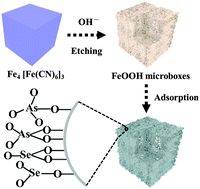Fabrication of FeOOH hollow microboxes for purification of heavy metal-contaminated water†
Abstract
FeOOH, a frequently used adsorbent, has been widely applied in purifying aqueous heavy metals, and its performance can be greatly improved by enlarging the number of surface active sites. To this end, we fabricated FeOOH hollow microboxes constructed from numerous 2D nanosheets via a template-engaged reaction between Prussian blue (PB) and NaOH solution. With combined observations from X-ray powder diffraction (XRD), scanning electron microscopy (SEM), transmission electron microscopy (TEM) and X-ray photoelectron spectroscopy (XPS), we confirmed that the hollow microboxes corroded from PB were composed of ample frizzy FeOOH nanosheets, which ensured extensive exposure of the surface active sites. Moreover, the FeOOH microboxes were utilized as an adsorbent in the removal of heavy metals (As(III), As(V) and Se(IV)) from water and the maximum adsorption capacities were reached up to 192.19 mg g−1, 250.0 mg g−1 and 169.9 mg g−1 at pH = 7.0, 4.0 and 5.0, respectively. The superior adsorptive performance of the FeOOH microboxes was derived from their large content of reactive exposed hydroxyl groups, which was unambiguously confirmed by X-ray adsorption fine structure spectroscopy (XAFS), as well as by surface site density analysis.


 Please wait while we load your content...
Please wait while we load your content...